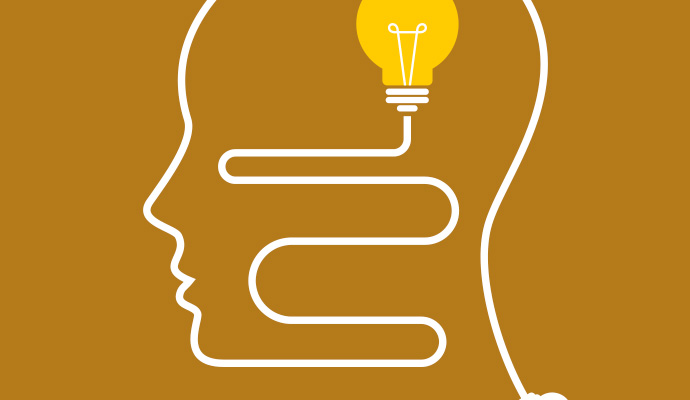See the world as a startup does
Professor Rory McDonald, an expert in disruptive strategy, urges corporate leaders to learn from startups—and preschoolers—as they seek to reinvent their organizations.

When it comes to innovation, established companies face an uncomfortable reality: Breakthrough new business models usually originate in startups. Indeed, at the heart of the innovator’s dilemma is the idea that by continuing to focus on what made your company successful with today’s customers, you may overlook tomorrow’s. “The big question,” says Rory McDonald, “is, How do you continue to get better at what you already do while reinventing yourself for the future?”
Part of the answer, McDonald argues, is learning to see the world as a startup does.
McDonald has dedicated his career to exploring innovation-related challenges and their solutions. His early research on startups drew the attention of Harvard’s Clayton Christensen, who became a mentor. Today, McDonald is the John Tyler Associate Professor of Business Administration at the University of Virginia’s Darden School of Business. He recently talked with strategy+business about business model reinvention, the disruptive potential (and limitations) of AI, and what business executives can learn about innovation from preschool children.
The following is an edited version of the conversation.
S+B: You were a protégé of the late Clayton Christensen, one of the most influential business thinkers in our lifetimes. How did you meet, and what was it like to work with him?
McDonald: I had recently completed my PhD at Stanford University and was teaching at the University of Texas at Austin, where I was a professor. I was sitting in my office one day when Clay called me up out of the blue. He said he’d heard about my research and asked me to come out to Harvard to give a presentation. And of course, we know Clay is the Harvard professor who developed the theory of disruptive innovation and introduced the world to the “innovator’s dilemma,” and this whole set of bold, counterintuitive ideas for why large, established companies struggle to stay on top of their markets. I had spent a lot of time in Silicon Valley and was approaching the question of disruption from the standpoint of startup companies—the disruptors, not the disruptees. We were looking at the same problem through two very different lenses.
What I found working with him is that he was just such a curious person, such a deep thinker, and fundamentally interested in helping managers understand their world a bit better. He was one of the rare people who was willing to use his research and theories to provoke others, even to the point of shocking them and inviting criticism of himself. He was very open to being wrong, but he wanted you to think.
I think he would be absolutely fascinated by the current business environment. I wish he was here because he’d be a great help to a great many people, including myself.
S+B: How would you describe the current landscape for innovation?
McDonald: If you think about all the forces out there, in some ways, they feel very new. But in other ways, they’re the usual suspects in different clothing, right? We’ve got emerging technologies—today it’s generative AI, quantum computing, personal genomics, and many others—and years back, it was the internet, and, before that, the PC. We still have consumer trends: everybody wants things better, faster, cheaper, more customized. We’ve got large, successful incumbents and venture-backed startups moving quickly all the time; we’ve got competitors who rarely stand still; we’ve got the forces of declining performance and shrinking market share, macroeconomic conditions, geopolitics, regulation. All of these factors challenge existing business models and enable the creation of new ones.
S+B: The disruptive force on everyone’s mind right now is, of course, GenAI. How does AI fit into your thinking?
McDonald: I like the analogy people use of the internet circa the mid-1990s, where you had this general-purpose technology emerging on the scene with the potential to revolutionize different sectors in different ways, spur economic growth, create competitive reorderings. It did this in some sectors—in retail, for example, the internet fundamentally reshaped business models and profit pools. But in other cases (financial services comes to mind), the internet arguably made many organizations better at what they already did, and therefore didn’t change competitive patterns nearly as much. So, in terms of how AI plays out, I think it all depends on how it is deployed, by whom, and when. It’s important to remember that AI is not necessarily just happening to us. We have choices—as leaders and organizations—about where and how we’re going to deploy it.
S+B: How do you anticipate those choices playing out in business models?
McDonald: Whenever there’s a new technology, a lot of companies are tempted to take the obvious first choice: Let’s use it to get better at our existing model and be better, faster, cheaper at what we already do. And we should, of course, because if we don’t, our rivals will overtake us.
But we could also think about using AI to fundamentally reshape our model. And I think the real winners that emerge as AI plays out are going to be the companies that focus on new business models, new revenue streams, new products and customers. A “better, faster, cheaper” version of your existing business model is not where the long-term economic growth of this technology will come from.
A ‘better, faster, cheaper’ version of your existing business model is not where the long-term economic growth of [AI] will come from.”
S+B: When it comes to that tension between the old and new models, how can incumbents approach the challenge?
McDonald: We all understand that the essence of a winning strategy is differentiation. We need to identify our competitors—existing and potential—and figure out how to outmaneuver them or differentiate from them in one way or another. But in new markets, particularly ones enabled by new technologies, it’s not clear which points of distinctiveness will matter to customers. Or even who the customer is. There will be a bunch of startups swimming in each space, and none of them really know what they’re doing—or which business model is going to make sense.
My coauthor Christopher Bingham and I studied this for our book. And one thing the research revealed is that as they proceed, both startups and successful corporate innovators act in a way that bears a striking resemblance to preschoolers engaging in parallel play. Preschoolers often play near one another, but not necessarily together. They keep an eye on what their peers are doing, and sometimes copy from them, but their focus is on their own activities. They borrow what works to make progress toward whatever goal they are trying to reach.
Similarly, startups and corporate innovators diversifying into new spaces treat competitors not as rivals to differentiate from, but as stepping stones to borrow ideas from—ideas about new products and new ways of creating value. This helps speed their progress to their own goal, which is usually having a viable business model in the new market. It’s a different way to think about rivalry and differentiation in new markets, as opposed to established ones.
S+B: How should companies think about customers and customer needs given the uncertainty surrounding these new markets?
McDonald: If we’re focusing on existing customers and trying to serve them better, then, by definition, there’s a set of customers we’re overlooking. Clay identified two types. One is the nonconsumption market: the folks who aren’t consuming your product or service but could; they just haven’t had the money, equipment, or skill to do so. The other is overserved customers, who would be happy to purchase your product or service with less performance than they’re currently getting, if the price were lower. I think that’s where AI will play an important role in helping companies reduce overhead, turn assets faster, and otherwise enable business models that earn attractive profits at the discount prices those customers want.
The fundamental unit of analysis here is the job the customer is trying to get done—the progress they want to achieve in a given situation, the problem they want the product or service to solve. The opportunities will be found in the customer frustrations, compensating behaviors, places where they’re hacking together crummy solutions. The message for companies is this: Don’t just take the data that’s walking in the door about customers. You need to go out and really try to understand the struggle and see what they are using instead of the product or service that you could develop.
S+B: That raises a provocative question. Can AI, which pulls from existing data, help us with breakthrough innovations?
McDonald: A robust debate is going on in the academic community about that question right now, and it’s one I’ve recently contributed to—namely, whether data will get in the way of thinking in a contrarian way.
We’ll know the answer eventually. It will play out in the literature. But for me, I tend to think that the more contrarian or outside the box we want to be, the harder it will be to leverage data, and by extension AI, to help us do that.
S+B: How would you describe the limitations of data when it comes to innovation?
McDonald: Nobody would say publicly, “We don’t want to be data-driven in our decisions.” But what if we ask, “Is it always appropriate to be data-driven in our decision-making?” Steve Jobs would say that if we did the market research and focus groups and surveys, we’d get data about what people think they want—as opposed to something people have never imagined but will truly love. And so, I think we want to be data-driven when it’s about getting better at what we already do, while recognizing that pathbreaking innovations often run counter to history. Clay used to say, very tongue in cheek, “For whatever reason, God only made data available about the past.”
I think it makes sense to be a little bit more discerning in our orientation toward the existing data, and to have some healthy skepticism. In the research for the book, I was surprised to learn that companies that we think of as being very data-driven have some important caveats. Netflix, for example, created a barrier between the data used in their operations and the data they give to their content creators. Everybody thinks content creation is driven by data, but if you just give people what they liked in the past, guess what? They would never make Stranger Things, a breakthrough hit that Netflix’s data predicted would be a flop.
Or think of Procter & Gamble [P&G] and Tide Pods—an example that a colleague, Ryan Allen, at the University of Washington and I recently wrote about. All of P&G’s historical data on related products—and even their early, forward-looking market tests—told them they had little chance of success. Meanwhile, they had these contradictory qualitative insights, like: “The customer would hold the Tide Pod in their hand like a jewel.” It turned out that the aesthetics were a huge draw for people.
S+B: What sort of practices can help with the data challenge?
McDonald: Ultimately, we want to cultivate an organizational culture in which a variety of types of evidence are seen as legitimate, potential sources of insight. One straightforward action companies can take is to assign a data heretic so that there’s always someone on the project who’s going to question the gospel, so to speak. Think of how John F. Kennedy famously assigned his brother Robert to be the devil’s advocate during the Cuban missile crisis. You need someone asking the hard questions, because the data will drive us to doing more and better for our best customers, which is the right thing to do—but not the only thing we need to be doing.
S+B: Imagine a CEO reading this interview. They lead a big incumbent, and they have more experience with incremental innovation than with the true business model reinvention they aspire to. Where should they start?
McDonald: There are a lot of business model frameworks out there, but I like the one PwC adapted from Clay’s original work [see graphic below] because it’s simple and allows you to quickly size up your own business model in a disciplined way. Doing so helps you spot strengths and be candid about vulnerabilities. For example, look at your key resources. So many executives will automatically say their key resources are people, but it simply cannot be true that everybody has the best people.
And when we identify the vulnerabilities, we can start asking, Where can we tweak our value proposition? What new capabilities do we need to deliver on a value proposition that would be interesting to customers we’re not currently reaching? What about our profit formula? There are so many things in the world that customers would like that we can’t produce profitably, and so many things we can produce profitably that customers wouldn’t like. What’s the intersection of all these things?
S+B: And for leaders at established companies who look at all these choices and feel stuck—they’re trying to navigate capital trade-offs, shareholder and stakeholder demands—what would you say to them?
McDonald: In class, when we ask students who they’d rather work for—incumbents or startups—about 80% of them say the established organization. It’s easy to take for granted the advantages incumbents have: the access to talent, resources, market power, brands, channels, the know-how. Yes, there are constraints, but if you’re a market-leading incumbent, why should you abdicate all those advantages to a startup?
Granted, this stuff is hard, but almost by definition you have a very successful organization. And the big question is, How do you continue to get better at what you already do while reinventing yourself for the future? It is possible. There are organizations that have done it repeatedly and reliably—not enough, but they’re out there. So I’d say: take advantage of all your strengths, use the research as inspiration to start seeing the world as a startup sees the world, and do what needs to be done.
Author profiles:
- Matthew Duffey is PwC’s Global Business Model Reinvention Leader. Based in Dallas, he is a principal with PwC US.
- Tom Fleming is an editorial director of strategy+business.



